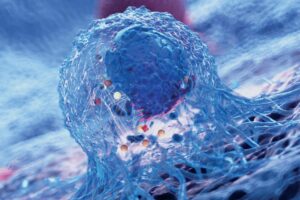Innovation has always guided Biofarma Group in designing and manufacturing cutting-edge products. The Group believes in exploring and selecting the best technologies available to conceive and manufacture products. Among these, using in silico technology and predictive studies is becoming increasingly important in the scientific field.
This area of medical research involves the creation of computer models using algorithms which can provide clinical data without in vivo or in vitro testing.
This innovative technology plays an increasingly important role in developing and testing new products in the pharmaceutical field, as it can provide predictions regarding the safety and efficacy of a formulation, as well as indicate optimal dosage strategies and generate the design of the supporting clinical study.
A significant difference in this research methodology from traditional studies is that conventional studies may indicate that a product is unsafe or ineffective but rarely show why or suggest how it could be improved. Therefore, a product that fails during clinical trials can be abandoned, although a minor modification could solve the problem. This stifles innovation, decreasing the number of genuinely original biomedical products presented on the market each year and, at the same time, increasing development costs.
The analysis through in silico clinical studies can provide a better understanding of the mechanism that caused the failure of the product during the validation phase and provide helpful information to refine the product to such an extent as to complete the tests successfully.
In addition, in silico clinical trials would also provide significant advantages over current preclinical practices: unlike animal models, virtual human models can be reused indefinitely, offering considerable cost savings, and can more effectively predict drug or device behavior in large-scale trials, identifying side effects that were previously difficult or impossible to detect.
Biofarma Group had the opportunity to test the high degree of innovation of in silico trials during the development and clinical validation process of its product Epatrex, a supplement that supports people suffering from non-alcoholic fatty liver disease. The application of this technology to the nutraceutical field represents a significant innovation, able to increase the effectiveness of innovation and development processes of new products.
An in-silico study for the clinical validation of a supplement against non-alcoholic fatty liver disease
Non-alcoholic fatty liver disease (NAFLD) is a highly prevalent reversible clinical condition affecting 25% of the adult population [1-3] and approximately 15% of children and already represents the second leading cause of liver transplantation in the United States [4]. The prevalence of the condition is double in obese and diabetic patients.
Almost a third of NAFLD cases can progress to a more aggressive form, non-alcoholic steatohepatitis (NASH), characterized by inflammation and progressive tissue degeneration, affecting about 5% of the general adult population and 20% of obese people. In 5 years, NAFLD and NASH, their “active” and progressive form, is expected to be the most common liver disease [9].
The main risk factors for these diseases are often linked to poor lifestyle habits, which can be accompanied by co-morbidities such as overweight and obesity, insulin resistance and type 2 diabetes, hypertriglyceridemia, hypercholesterolemia, sleep apnea, hypothyroidism, cardiovascular diseases, extra-hepatic tumors (breast and colorectal) and chronic kidney disease. In addition, NASH can also progress to cirrhosis or hepatocellular carcinoma (HCC).
There are currently no pharmaceutical or nutraceutical treatments for NAFLD or NASH. However, there are several molecules in clinical trials, and all available guidelines suggest only lifestyle modifications such as diet, physical activity, and cognitive-behavioral psychotherapy.
This is why the Research and Development laboratories of Biofarma Group considered that a nutraceutical capable of improving biochemical markers or steatosis score could be helpful as an additional therapy to lifestyle modifications, providing essential support to subjects suffering from this condition.
From this idea was born Epatrex, a new nutraceutical compound formulated as a three-layer tablet containing the probiotic Lactobacillus casei LC-XCAL, of which the ability to reduce triglyceride levels has been observed both in animal models and in humans; silymarin which acts as an antioxidant on beta-oxidation and as an antifibrotic agent in humans and chromium picolinate able to increase the absorption of cellular glucose and improve lipid metabolism, reducing the value of triglycerides.
The clinical validation process of nutraceutical compost involved two phases: the first consisted of a multicenter, randomized, single-blind, parallel and cross-over clinical trial, the results of which clearly demonstrated that the product under investigation is safe. However, although there was a trend of decrease in transaminases (primary endpoint) in only two months of treatment, there were no statistically significant differences in epatrex compared to placebo concerning blood markers of liver inflammation.
The authors hypothesized that the lack of efficacy was probably due to the very heterogeneous underlying conditions of the patients and/or the insufficient duration of the treatment period and that, therefore, the product merited further investigation, also considering that the expectation of efficacy of Epatrex is based on relatively solid hypotheses emerged from the analysis of existing hepatoprotective nutraceutical products. To this end, a second study was conducted, taking advantage of the in silico methodology, which allowed us to obtain new important information through the analysis and re-elaboration of the data emerging from the first trial. This second study was carried out in collaboration with InSilicoTrials, a leading company in the use of computational simulations and advanced artificial intelligence tools to enhance and accelerate the development of drugs and medical devices.
The study made it possible to analyze an additional clinical endpoint, namely the Hamaguchi score, and evaluate the influence exerted by the study design and the specific characteristics of the patient to provide recommendations for future clinical studies.
The results showed a significant association between the treatment period and changes in Hamaguchi score. A much more considerable placebo effect was observed in the second period than in the first. This has probably compromised the identification of the statistical significance of the nutraceutical effect. Placebo effects may increase over time due to the so-called “Hawthrone effect”, whereby the awareness of being observed causes patients to adopt a healthier lifestyle. In future analyses, the acquisition of data on diet (caloric intake, diet composition, alcohol consumption) and physical activity over time will be considered to adjust for factors that influence placebo response.
In addition, during the analysis, alcohol consumption assessed at screening was statistically significant on changes in Hamaguchi score from baseline, indicating alcohol consumption as a confounding factor in measuring treatment effect.
Finally, particularly important is the effect of the product observed on patients with a high waist circumference (WC). The study’s results followed a statistically relevant relationship between changes in Hamaguchi score and WC-treatment interaction, suggesting a stronger effect of Epatrex in patients with greater waist circumference.
In conclusion, the results of this analysis carried out through in silico technology provide essential indications on how to improve the design of clinical trials and represent a first step towards a mechanistic understanding of the effects of Epatrex on non-alcoholic fatty liver disease.
Reference
- Bedogni, G., Miglioli, L., Masutti, F., Tiribelli, C., Marchesini, G., Bellentani, S. (2005) Prevalence of and risk factors for nonalcoholic fatty liver disease: the Dionysos nutrition and liver study. Hepatology, 42(1): 44-52.
- Bellentani, S., Marino, M. (2009) Epidemiology and natural history of non-alcoholic fatty liver disease (NAFLD). Annals of Hepatology, 8 Suppl 1, S4-S8.
- Bellentani, S., Scaglioni, F., Marino, M., Bedogni, G. (2010) Epidemiology of non-alcoholic fatty liver disease. Dig Dis, 28(1): 155-161.
- Loomba, R., Sanyal, AJ. (2013) The global NAFLD epidemic. Nat Rev Gastroenterol Hepatol, 10(11): 686-690.
- Bellentani, S., Murzilli, S., Vanelli, A. (2020) A New Combination of 2 Nutraceuticals and 1 Probiotic (Epatrex) for Non-Alcoholic Fatty Liver Disease (NAFLD): Results from a Multi-Centre, Randomized, Single-Blind, Parallel, Cross-Over Study: the “REVEAL” Study. J Clin Nutr Food Sci, 3(2): 01-13.
- Baretta, A., Nicolò, C., Murzilli, S., Vanelli, A., and Roberta Bursi, Statistical modelling analysis to assess the effects of Epatrex on Hamaguchi score in subjects with Non-Alcoholic Fatty Liver Disease (NAFLD), Nutrients 2023













